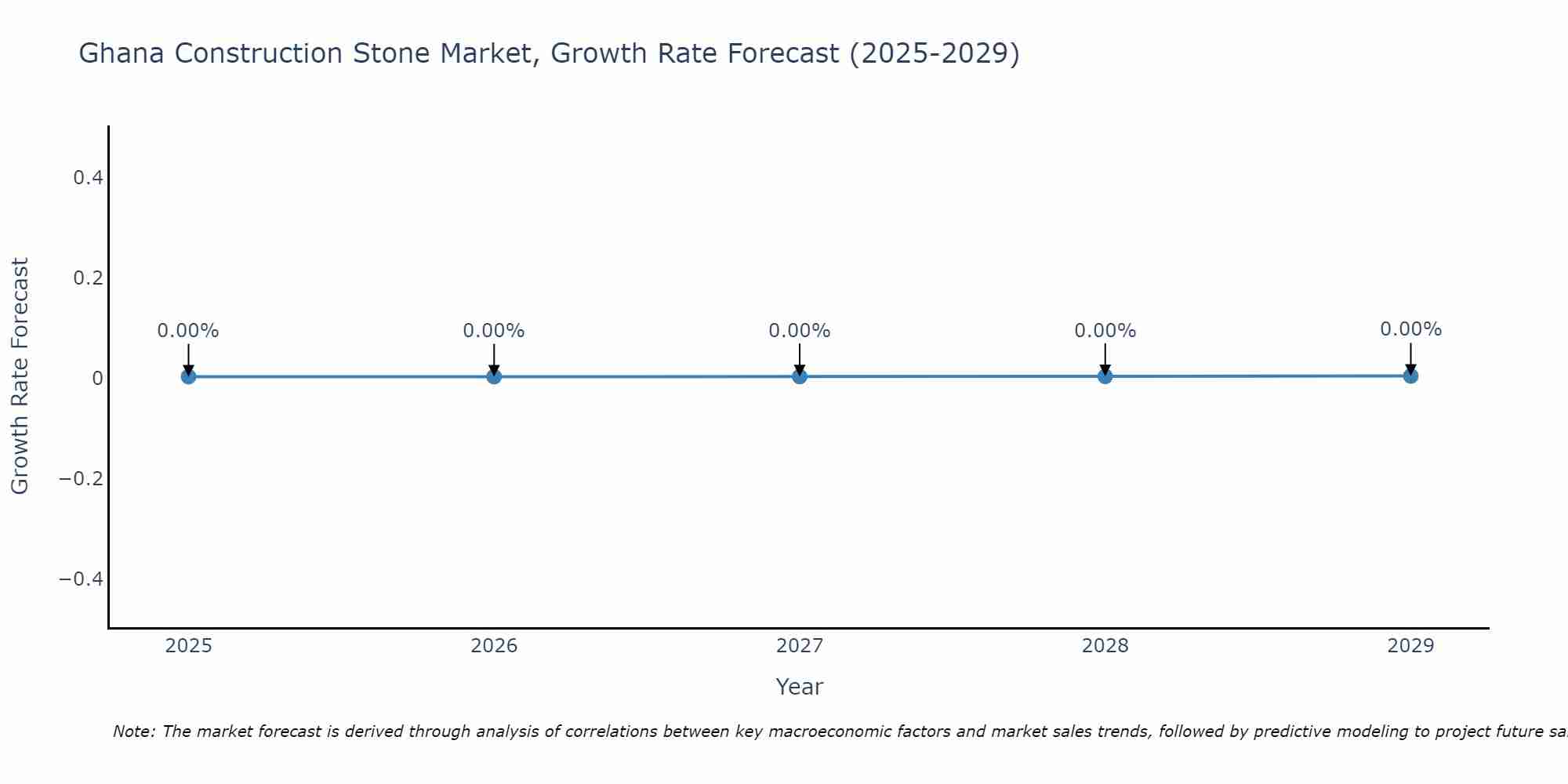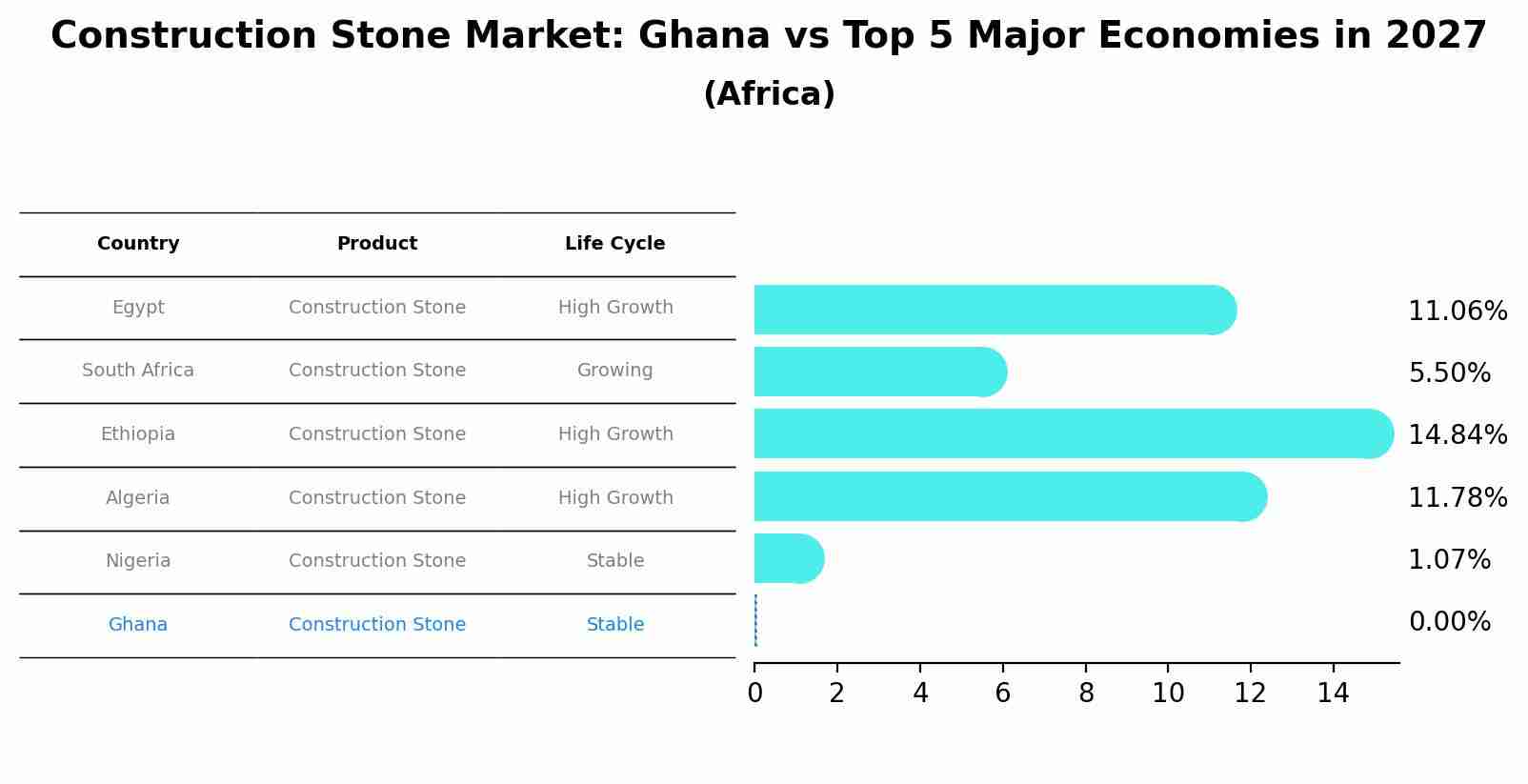Ghana Construction Stone Market (2025-2031) Outlook | Revenue, Share, Forecast, Industry, Growth, Size, Value, Analysis, Trends & Companies
| Product Code: ETC274076 | Publication Date: Aug 2022 | Updated Date: Jul 2025 | Product Type: Market Research Report | |
| Publisher: 6Wresearch | Author: Vasudha | No. of Pages: 75 | No. of Figures: 35 | No. of Tables: 20 |
Ghana Construction Stone Market Size Growth Rate
The Ghana Construction Stone Market is poised for steady growth rate improvements from 2025 to 2029. From 0.00% in 2025, the growth rate steadily ascends to 0.00% in 2029.

Construction Stone Market: Ghana vs Top 5 Major Economies in 2027 (Africa)
By 2027, Ghana's Construction Stone market is forecasted to achieve a stable growth rate of 0.00%, with Egypt leading the Africa region, followed by South Africa, Ethiopia, Algeria and Nigeria.

Ghana Construction Stone Market Overview
The Ghana construction stone market is experiencing steady growth driven by increasing infrastructure development projects in the country. The demand for construction stones such as granite, limestone, and sandstone is rising due to the expansion of residential, commercial, and industrial construction activities. Local quarries and suppliers play a crucial role in meeting this demand, providing a variety of stone products for building purposes. The market is also influenced by factors such as government investments in infrastructure, urbanization trends, and the growing middle-class population. As sustainability and environmental considerations become more important, there is a shift towards using locally sourced and eco-friendly stone materials in construction projects. Overall, the Ghana construction stone market presents opportunities for growth and innovation in the coming years.
Ghana Construction Stone Market Trends
The Ghana Construction Stone Market is witnessing several key trends. Firstly, there is a growing demand for sustainable and eco-friendly construction materials, leading to an increased interest in locally sourced and natural stone products. Secondly, technological advancements in stone extraction, processing, and finishing are enhancing the quality and variety of stones available in the market. Additionally, the rise in infrastructure development projects in Ghana is driving the demand for construction stones, particularly for road construction and building projects. Moreover, there is a noticeable shift towards innovative and unique stone designs and applications in modern construction projects, reflecting the evolving preferences of architects and builders in the country. Overall, the Ghana Construction Stone Market is experiencing a dynamic shift towards sustainability, technology integration, and design innovation.
Ghana Construction Stone Market Challenges
In the Ghana Construction Stone Market, some key challenges include inconsistent supply of quality stones, inadequate infrastructure for stone quarrying and transportation, lack of regulation leading to illegal mining activities, and limited access to financing for small-scale stone quarry operators. These challenges result in fluctuating prices, delays in construction projects, environmental degradation, and safety hazards for workers. Additionally, the industry faces issues related to land tenure conflicts, inefficient extraction techniques, and limited technical expertise. Addressing these challenges will require collaboration between government entities, industry stakeholders, and local communities to implement sustainable practices, improve infrastructure, enhance regulatory frameworks, and provide support for skill development and financing initiatives in the sector.
Ghana Construction Stone Market Investment Opportunities
The Ghana Construction Stone Market presents promising investment opportunities due to the country`s growing infrastructure development projects and the increasing demand for quality construction materials. Investing in quarries that produce high-quality stones such as granite, limestone, and sandstone can be lucrative, as these materials are essential for building roads, bridges, residential and commercial buildings, and other infrastructure projects. Additionally, investing in stone processing facilities to enhance the value of the raw materials through cutting, polishing, and shaping can also be a profitable venture. With the government`s focus on infrastructure development and the construction sector`s continuous growth, investing in the Ghana Construction Stone Market has the potential for long-term returns and sustainability.
Ghana Construction Stone Market Government Policy
Government policies in Ghana related to the construction stone market include regulations governing the mining and quarrying of stones, environmental protection measures, and licensing requirements for operators. The Minerals and Mining Act of 2006 regulates the mining of stones, ensuring compliance with health, safety, and environmental standards. The Environmental Protection Agency (EPA) oversees environmental impact assessments for stone mining operations to mitigate environmental degradation. Additionally, operators in the construction stone market are required to obtain licenses and permits from the Minerals Commission to operate legally. These policies aim to promote sustainable and responsible mining practices, protect the environment, and ensure the safety of workers in the construction stone market in Ghana.
Ghana Construction Stone Market Future Outlook
The future outlook for the Ghana Construction Stone Market appears promising due to the country`s growing infrastructure development projects and urbanization. With a rising population and increasing demand for residential, commercial, and industrial buildings, the need for construction stones such as granite, limestone, and sandstone is expected to remain high. Additionally, government initiatives to improve the country`s transportation network, including road construction projects, will further drive the demand for construction stones. However, challenges such as environmental regulations and sourcing sustainable materials may impact the market in the long term. Overall, opportunities for growth in the Ghana Construction Stone Market are likely to continue, supported by ongoing construction activities and infrastructure development efforts.
Key Highlights of the Report:
- Ghana Construction Stone Market Outlook
- Market Size of Ghana Construction Stone Market, 2024
- Forecast of Ghana Construction Stone Market, 2031
- Historical Data and Forecast of Ghana Construction Stone Revenues & Volume for the Period 2021 - 2031
- Ghana Construction Stone Market Trend Evolution
- Ghana Construction Stone Market Drivers and Challenges
- Ghana Construction Stone Price Trends
- Ghana Construction Stone Porter's Five Forces
- Ghana Construction Stone Industry Life Cycle
- Historical Data and Forecast of Ghana Construction Stone Market Revenues & Volume By Type for the Period 2021 - 2031
- Historical Data and Forecast of Ghana Construction Stone Market Revenues & Volume By Construction Aggregates for the Period 2021 - 2031
- Historical Data and Forecast of Ghana Construction Stone Market Revenues & Volume By Natural Stones for the Period 2021 - 2031
- Historical Data and Forecast of Ghana Construction Stone Market Revenues & Volume By Application for the Period 2021 - 2031
- Historical Data and Forecast of Ghana Construction Stone Market Revenues & Volume By Public Infrastructure for the Period 2021 - 2031
- Historical Data and Forecast of Ghana Construction Stone Market Revenues & Volume By Commercial Infrastructure for the Period 2021 - 2031
- Historical Data and Forecast of Ghana Construction Stone Market Revenues & Volume By Residential Infrastructure for the Period 2021 - 2031
- Ghana Construction Stone Import Export Trade Statistics
- Market Opportunity Assessment By Type
- Market Opportunity Assessment By Application
- Ghana Construction Stone Top Companies Market Share
- Ghana Construction Stone Competitive Benchmarking By Technical and Operational Parameters
- Ghana Construction Stone Company Profiles
- Ghana Construction Stone Key Strategic Recommendations
Frequently Asked Questions About the Market Study (FAQs):
1 Executive Summary |
2 Introduction |
2.1 Key Highlights of the Report |
2.2 Report Description |
2.3 Market Scope & Segmentation |
2.4 Research Methodology |
2.5 Assumptions |
3 Ghana Construction Stone Market Overview |
3.1 Ghana Country Macro Economic Indicators |
3.2 Ghana Construction Stone Market Revenues & Volume, 2021 & 2031F |
3.3 Ghana Construction Stone Market - Industry Life Cycle |
3.4 Ghana Construction Stone Market - Porter's Five Forces |
3.5 Ghana Construction Stone Market Revenues & Volume Share, By Type, 2021 & 2031F |
3.6 Ghana Construction Stone Market Revenues & Volume Share, By Application, 2021 & 2031F |
4 Ghana Construction Stone Market Dynamics |
4.1 Impact Analysis |
4.2 Market Drivers |
4.3 Market Restraints |
5 Ghana Construction Stone Market Trends |
6 Ghana Construction Stone Market, By Types |
6.1 Ghana Construction Stone Market, By Type |
6.1.1 Overview and Analysis |
6.1.2 Ghana Construction Stone Market Revenues & Volume, By Type, 2021 - 2031F |
6.1.3 Ghana Construction Stone Market Revenues & Volume, By Construction Aggregates, 2021 - 2031F |
6.1.4 Ghana Construction Stone Market Revenues & Volume, By Natural Stones, 2021 - 2031F |
6.2 Ghana Construction Stone Market, By Application |
6.2.1 Overview and Analysis |
6.2.2 Ghana Construction Stone Market Revenues & Volume, By Public Infrastructure, 2021 - 2031F |
6.2.3 Ghana Construction Stone Market Revenues & Volume, By Commercial Infrastructure, 2021 - 2031F |
6.2.4 Ghana Construction Stone Market Revenues & Volume, By Residential Infrastructure, 2021 - 2031F |
7 Ghana Construction Stone Market Import-Export Trade Statistics |
7.1 Ghana Construction Stone Market Export to Major Countries |
7.2 Ghana Construction Stone Market Imports from Major Countries |
8 Ghana Construction Stone Market Key Performance Indicators |
9 Ghana Construction Stone Market - Opportunity Assessment |
9.1 Ghana Construction Stone Market Opportunity Assessment, By Type, 2021 & 2031F |
9.2 Ghana Construction Stone Market Opportunity Assessment, By Application, 2021 & 2031F |
10 Ghana Construction Stone Market - Competitive Landscape |
10.1 Ghana Construction Stone Market Revenue Share, By Companies, 2024 |
10.2 Ghana Construction Stone Market Competitive Benchmarking, By Operating and Technical Parameters |
11 Company Profiles |
12 Recommendations |
13 Disclaimer |
- Single User License$ 1,995
- Department License$ 2,400
- Site License$ 3,120
- Global License$ 3,795
Search
Related Reports
- Portugal Electronic Document Management Market (2025-2031) | Strategy, Consumer Insights, Analysis, Investment Trends, Opportunities, Growth, Size, Share, Industry, Revenue, Segments, Value, Segmentation, Supply, Forecast, Restraints, Outlook, Competition, Drivers, Trends, Demand, Pricing Analysis, Competitive, Strategic Insights, Companies, Challenges
- France Electronic Document Management Market (2025-2031) | Strategy, Consumer Insights, Analysis, Investment Trends, Opportunities, Growth, Size, Share, Industry, Revenue, Segments, Value, Segmentation, Supply, Forecast, Restraints, Outlook, Competition, Drivers, Trends, Demand, Pricing Analysis, Competitive, Strategic Insights, Companies, Challenges
- Portugal Occupational Health & Safety Services Market (2025-2031) | Strategy, Consumer Insights, Analysis, Investment Trends, Opportunities, Growth, Size, Share, Industry, Revenue, Segments, Value, Segmentation, Supply, Forecast, Restraints, Outlook, Competition, Drivers, Trends, Demand, Pricing Analysis, Competitive, Strategic Insights, Companies, Challenges
- Netherlands Occupational Health and Safety Services Market (2025-2031) | Strategy, Consumer Insights, Analysis, Investment Trends, Opportunities, Growth, Size, Share, Industry, Revenue, Segments, Value, Segmentation, Supply, Forecast, Restraints, Outlook, Competition, Drivers, Trends, Demand, Pricing Analysis, Competitive, Strategic Insights, Companies, Challenges
- Belgium and Luxembourg Facility Management Market (2025-2031) | Strategy, Consumer Insights, Analysis, Investment Trends, Opportunities, Growth, Size, Share, Industry, Revenue, Segments, Value, Segmentation, Supply, Forecast, Restraints, Outlook, Competition, Drivers, Trends, Demand, Pricing Analysis, Competitive, Strategic Insights, Companies, Challenges
- Russia Women Intimate Apparel Market (2025-2031) | Strategy, Consumer Insights, Analysis, Investment Trends, Opportunities, Growth, Size, Share, Industry, Revenue, Segments, Value, Segmentation, Supply, Forecast, Restraints, Outlook, Competition, Drivers, Trends, Demand, Pricing Analysis, Competitive, Strategic Insights, Companies, Challenges
- Africa Chocolate Market (2025-2031) | Size, Share, Trends, Growth, Revenue, Analysis, Forecast, industry & Outlook
- Global Hydroxychloroquine And Chloroquine Market (2025-2031) | Industry, Trends, Size, Outlook, Growth, Value, Companies, Revenue, Analysis, Share, Forecast
- Saudi Arabia Plant Maintenance Market (2025-2031) | Industry, Size, Growth, Revenue, Value, Companies, Forecast, Analysis, Share & Trends
- Taiwan Electric Truck Market (2025-2031) | Outlook, Industry, Revenue, Size, Forecast, Growth, Analysis, Share, Companies, Value & Trends
Industry Events and Analyst Meet
Our Clients
Whitepaper
- Middle East & Africa Commercial Security Market Click here to view more.
- Middle East & Africa Fire Safety Systems & Equipment Market Click here to view more.
- GCC Drone Market Click here to view more.
- Middle East Lighting Fixture Market Click here to view more.
- GCC Physical & Perimeter Security Market Click here to view more.
6WResearch In News
- Doha a strategic location for EV manufacturing hub: IPA Qatar
- Demand for luxury TVs surging in the GCC, says Samsung
- Empowering Growth: The Thriving Journey of Bangladesh’s Cable Industry
- Demand for luxury TVs surging in the GCC, says Samsung
- Video call with a traditional healer? Once unthinkable, it’s now common in South Africa
- Intelligent Buildings To Smooth GCC’s Path To Net Zero













